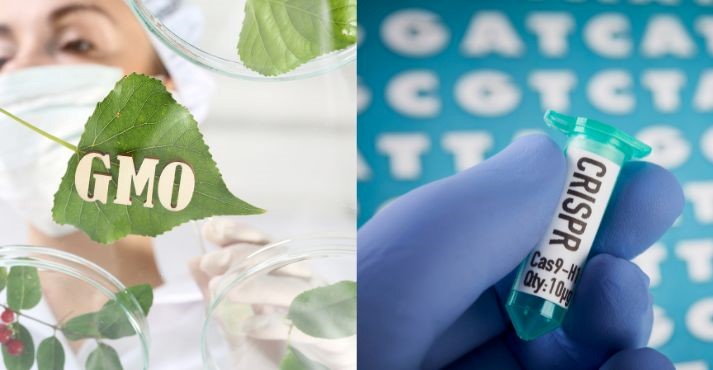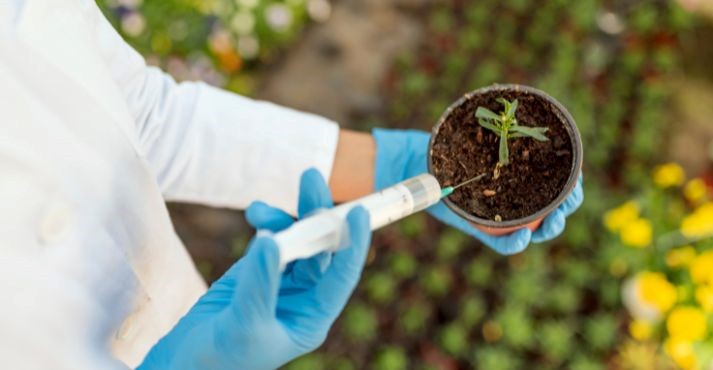Scientists are working on new techniques to produce more food to feed the growing population. Among such technologies, CRISPR in food is gaining popularity.
With extreme weather and droughts becoming more commonplace and increasing pollution, pest outbreaks, and competition, food manufacturers are looking for new food production methods.
Recently, attention has been directed to a new molecular technique called CRISPR gene-editing technology for introducing commercially desirable traits in crops.
Researchers are leveraging CRISPR food technology to enhance staple crops and make them more resilient to extreme environments.
CRISPR will soon surpass GMOs as the most influential gene-editing technology for food production. With foodtech advancing, CRISPR can redefine the future food supply, making significant strides to resolve the challenges of the modern world.
In this blog, we will explore everything you need to know about how CRISPR genetic modification will transform the shape of the F&B industry.
Understanding CRISPR

CRISPR, which stands for Clustered Regularly Interspaced Short Palindromic Repeats, is a revolutionary gene-editing technology.
It’s applied to selective breeding, as scientists edit a plant’s genome to get desired traits. Gene editing is also simpler, cheaper, and faster than creating GMOs.
CRISPR genetic modification utilizes RNA molecules and associated proteins to target and modify specific genes within an organism’s DNA. The process begins with synthesizing RNA sequences that match the target genes.
When introduced into a cell, these RNA molecules guide the CRISPR-associated proteins to the targeted DNA, where they induce precise modifications.
CRISPR technology has wide-ranging applications, from correcting genetic defects in humans to enhancing crop resilience.
In agriculture, it enables the development of crops with improved resistance to pests and diseases, making the food supply chain more resilient. Its precision makes CRISPR a powerful technique for food manufacturers.
Moreover, food manufacturers can benefit from increased efficiency in production, reduced post-harvest losses, and the ability to meet consumer demands for healthier and sustainable food options.
CRISPR’s precision and versatility are valuable for advancing food science and agritech practices and ensuring a more reliable food supply chain.
CRISPR in Food Production

CRISPR has many significant implications for enhanced global agriculture with gene editing of crops and improvements in food security. It can extend the ability to develop new capabilities in applied biotechnology and its effects on increased world food production.
Here are some of the critical applications of CRISPR in food production.
Crop Improvement
CRISPR technology enhances crop traits by precisely editing their genetic code. Scientists design RNA sequences that match specific genes associated with desirable traits such as yield, nutritional content, and resistance to pests or diseases.
CRISPR offers a highly efficient and precise method for modifying crops to meet evolving agricultural needs. Using CRISPR-associated proteins, these RNA molecules guide targeted modifications in the plant’s DNA, promoting the expression of desired characteristics.
For instance, researchers can boost crop yields by changing the genes related to growth and development, enhance nutritional content by fortifying essential nutrients, and confer resistance to pests or diseases by modifying genes involved in the plant’s defense mechanisms.
Extended Shelf Life
CRISPR is applied to modify genes related to fruit ripening and decay by targeting specific genetic elements that regulate these processes. Scientists design RNA sequences that match genes responsible for controlling ripening and susceptibility to decay.
For instance, suppressing genes associated with ripening can extend shelf life, extend freshness, and reduce post-harvest losses, while enhancing those involved in resistance to decay-causing pathogens can reduce spoilage.
CRISPR-edited crops offering extended shelf life benefit food manufacturers by reducing post-harvest losses and minimizing waste. This translates to improved supply chain efficiency, reduced costs associated with rapid product turnover, and increased availability of fresh produce. The extended shelf life of CRISPR-edited crops positively impacts food manufacturers by enhancing product quality throughout the distribution process.
Nutritional Enhancement
CRISPR is utilized to enhance the nutritional content of crops by targeting specific genes associated with desired nutritional traits. Researchers design RNA sequences corresponding to genes controlling the synthesis of essential nutrients such as vitamins or minerals.
CRISPR-associated proteins then enable precise modifications in the crop’s DNA, promoting the increased production of targeted nutrients. This approach allows for the development of crops with improved nutritional profiles, addressing deficiencies and enhancing the health benefits of the harvested produce.
Customized Functional Foods
Functional foods with health benefits beyond essential nutrition—are becoming a subject of high interest and demand. CRISPR modifies crop genes to boost specific nutrients, creating foods with heightened nutritional content for health benefits.
Determine the specific health benefits or functional properties you want to enhance, such as increased nutrient content, reduced allergens, or enhanced bioactive compounds. Identify the genes responsible for the desired traits.
Develop RNA sequences that match the identified target genes. Introduce CRISPR constructs into the plant or organism of interest. Grow the edited crops under controlled conditions. Harvest the crops when they reach maturity, considering the specific requirements for functional foods.
Reduce Food Wastage
Food wastage can be reduced with CRISPR by engineering crops for increased shelf life, resistance to pests, and improved post-harvest traits. CRISPR reduces environmental pollution by minimizing food waste and generating biofuel from waste.
CRISPR can make fruits and veggies last longer by changing genes that control ripening. This slows down the ripening process, so they stay fresh longer. This helps stop them from going bad quickly, so we don’t waste as much food after it’s picked. With CRISPR, we can have more fresh produce available for a longer time, which is good for reducing waste.
According to a research study, CRISPR’s versatility and high level of competence have already made CRISPR a remarkable practical tool to achieve Sustainable Development Goals (SDGs) such as ensuring food security, decreasing agricultural and food loss, mitigating greenhouse gas emissions and environmental protection.
GMOs vs. CRISPR

Genetically modified organisms (GMOs) are one well-known example of agricultural biotechnology. Gene editing, often known as CRISPR, is also new to agritech and adds more complexity to a field filled with misperceptions and misinformation.
To draw a clear distinction between traditional genetically modified organisms (GMOs) and CRISPR genetic engineering of food, let’s explore the differences based on the following factors.
- Methodology
GMOs involve inserting foreign genes, often from different species, using various methods. CRISPR-edited crops precisely modify existing genes within a species using targeted gene-editing tools, offering a more specific and controlled approach.
- Precision
GMOs may cause unintended genetic changes due to less precise insertion. CRISPR allows exact modifications, minimizing off-target effects and enhancing control over crop genetic alterations.
- Regulatory Status
GMOs typically face regulations due to concerns about potential environmental and health impacts. CRISPR-edited crops, seen as more precise and natural, may undergo less regulatory scrutiny, although this varies globally.
- Public Perception
GMOs often face public skepticism due to concerns about safety and ethics. CRISPR-edited crops are perceived as more acceptable, with some viewing them as a natural extension of traditional breeding, potentially leading to greater public acceptance.
- Applications
GMOs are used for various traits, including pest resistance and herbicide tolerance. CRISPR allows for more targeted applications, such as enhancing nutritional content or modifying specific aspects without introducing foreign genes, providing a more versatile approach to crop improvement.
To further understand the distinction, consider the example of the Bt Corn crop.
GMO Bt corn is engineered with a bacterial gene that produces a protein toxic to certain pests, like the corn borer. This modification reduces the need for chemical pesticides, promoting healthier crops and potentially increasing yields by protecting corn from destructive pests during the growing season.
Using CRISPR, researchers can precisely modify specific genes in corn to enhance traits such as drought resistance or nutritional content. For instance, editing genes related to water usage could help corn plants thrive in arid conditions, improving yields.
Benefits of CRISPR in Agriculture

CRISPR in agriculture has transformed food biology beyond all expectations.
CRISPR, a powerful tool in farming, helps crops handle tricky situations like changing weather. By studying genes with CRISPR, scientists can make plants strong against pests, diseases, and even herbicides.
This means farmers can grow crops, even using chemicals to fight weeds. With climate changes, it’s essential to challenge crops against droughts and extreme weather.
CRISPR also improves crops for us—like making wheat safe for people with gluten issues. CRISPR helps farmers grow more food by changing genes for plant growth.
Moreover, CRISPR technology enables urban farming in Southeast Asia, delivering economic benefits for farmers and society. For instance, Chinese scientists reported creating a strain of wheat resistant to powdery mildew, a destructive fungal disease.
Here are some of the critical benefits of CRISPR in agriculture.
Precision Agriculture
CRISPR brings precision agriculture to farming by allowing targeted gene edits. Farmers can modify specific genes to enhance traits like drought resistance or pest tolerance, tailoring crops to their unique needs and the environment.
For example, CRISPR can enable the precise adjustment of genes related to water use efficiency in crops, optimizing resource utilization.
Increased Crop Yield
CRISPR enhances crop yield by editing genes associated with plant growth and stress responses. For example, researchers have applied CRISPR to improve rice yield by making targeted gene mutations that influence growth, resulting in higher productivity.
Improved Crop Resilience
CRISPR enhances crop resilience by modifying genes responsible for stress responses and diseases. This helps crops withstand challenges like extreme weather conditions or evolving pests.
For example, CRISPR can redefine a plant’s defenses against specific diseases, ensuring healthier and more resilient crops.
Reduced Dependency on Chemical Inputs
CRISPR-edited crops can be engineered to resist pests or diseases naturally, reducing the need for chemical pesticides. This environmentally friendly approach promotes sustainable agriculture and minimizes the ecological impact of farming practices.
For example, CRISPR can create crops with built-in resistance to certain pests, reducing the reliance on chemical treatments.
Conclusion
CRISPR in food is a helpful gene editing tool that can make fruits and veggies better for us and safer to eat. With its precision and versatility, CRISPR enables the development of crops tailored to meet the evolving challenges of agriculture.
By addressing issues such as climate change, resource scarcity, and the need for sustainable farming practices, CRISPR contributes to increased crop yield, improved resilience, and reduced environmental impact.
The ability to precisely edit genes offers solutions for developing crops with enhanced nutritional content, longer shelf life, and reduced allergens.
Scientists are always trying to make the future of CRISPR even better to do more things and be even more precise.
As CRISPR advances, its applications in agriculture are set to revolutionize how we grow, harvest, and consume food, creating a more resilient, efficient, and sustainable future food supply.












